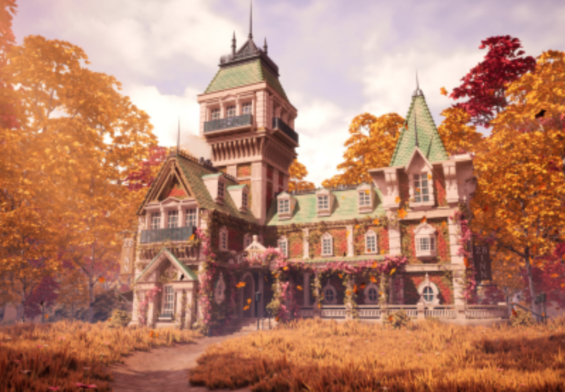A glimpse of the Environment Art logic behind Diablo 4 and Hogwarts Legacy
Introduction
Junliang Zhang is currently a scene development artist at Blizzard Entertainment in Irvine, USA. He has been playing video games for 15 years and loves AAA games as he thinks AAA games stand for high-quality graphics and gameplay, which inspires ideas for environment art-piece creation.
Junliang’s specialty lies in cinematic and gameplay lightening and compositing, physical rendering, color grading, post-processing for indoor and outdoor lighting, UE4 shaders creation, etc. His frequently used software tools include but are not limited to PS, Substance Painter, Brush, Maya, 3D, WorldMachine, Houdini, UE4, Unity etc. Junliang’s artworks have received tons of attention from digital art press and 3D art space. His 2019 3D project “CyberNeon Chinese City” was highly acclaimed among the UE4 and Unity communities.
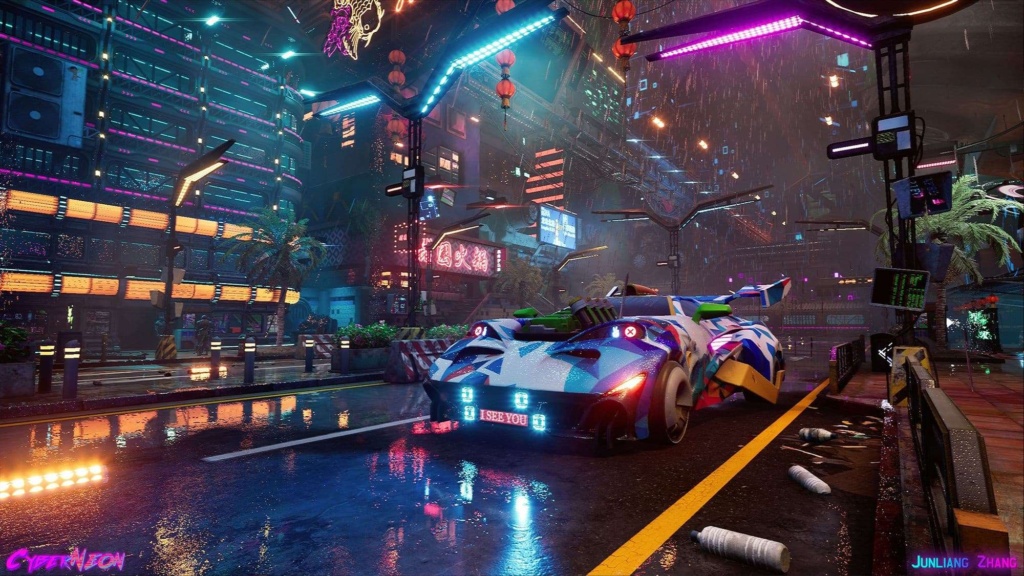
(CyberNeon City)
Artizen tries to explore the development process and art direction behind AAA game projects such as Diablo and Hogwarts Legacy with Junliang, he has been working with the Diablo 4 team for the past 3 years, and his sharing of AAA projects will provide valuable inspiration to those artists who aspire to work with top game developers and students who are looking for mentoring help from the industry’s perspective.
Diablo IV
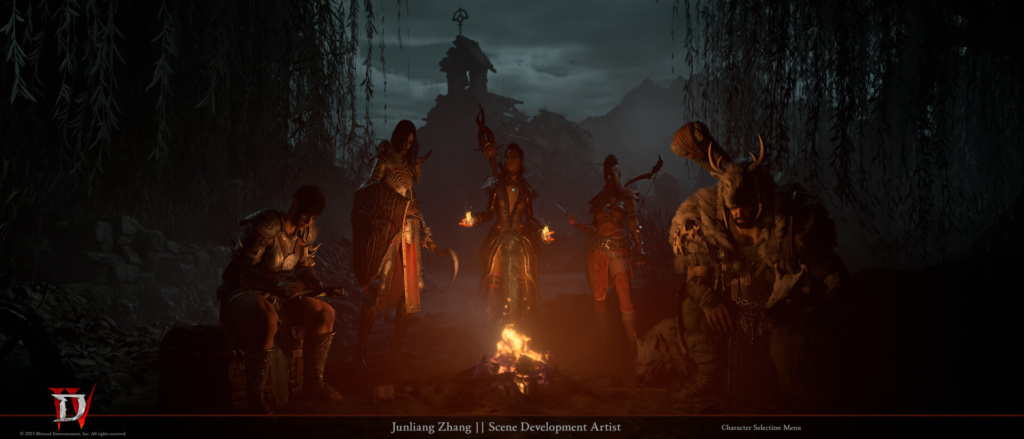
(Character Wardrobe Design)
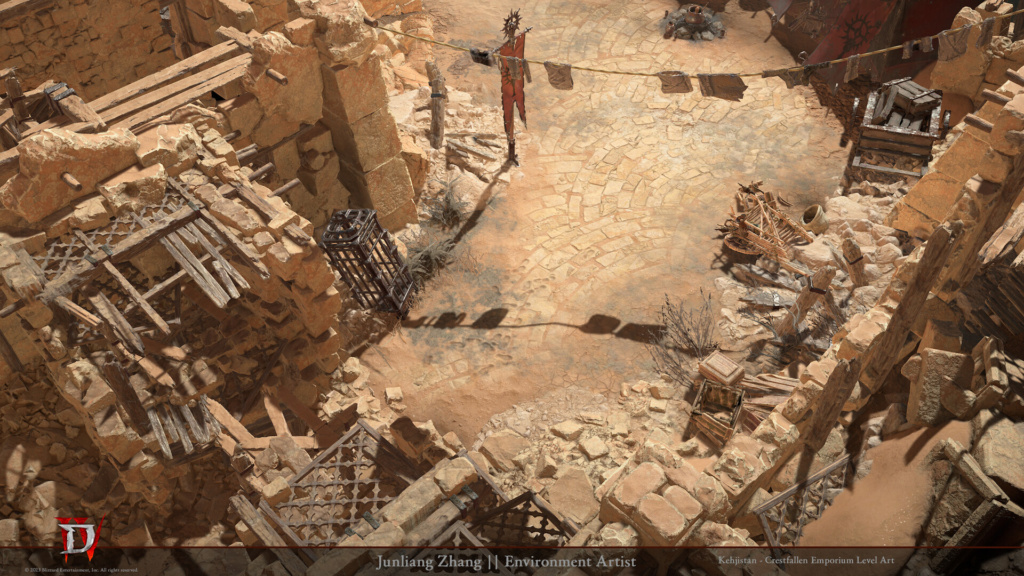
(Interior & Exterior environmental design)
1. What’s the environmental design process at Blizzard? For the characters and locations, do you have a sketch draft or silhouette from other 2D artist or concept artist, how do you guys collaborate? (Dry stepps, fractured peaks, dungeons, shipwreck tangle)
In the process of game environment design, collaboration is crucial. This process is often the result of the joint efforts of multiple links and team members, including 2D artists, concept artists, 3D modelers, technical artists, and environment designers, among others. Each person plays a key role in the creative process, working together to create an engaging game world.
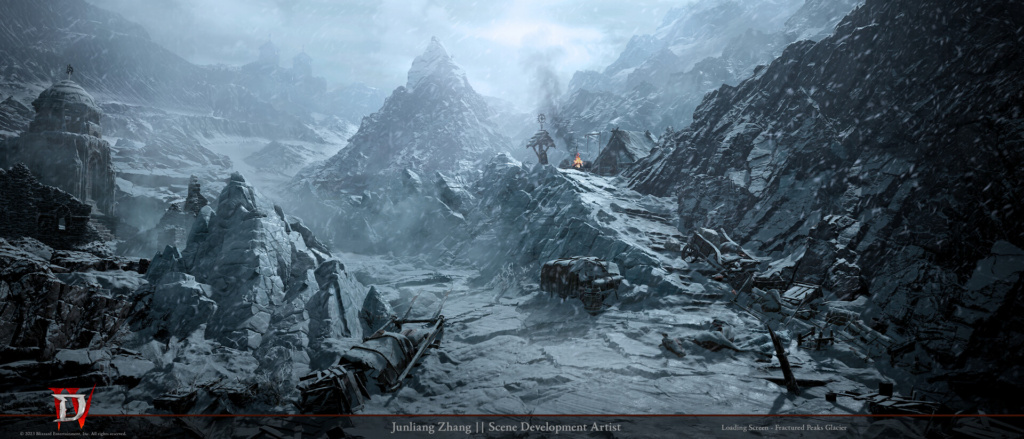
(Fractured Peaks Castle)
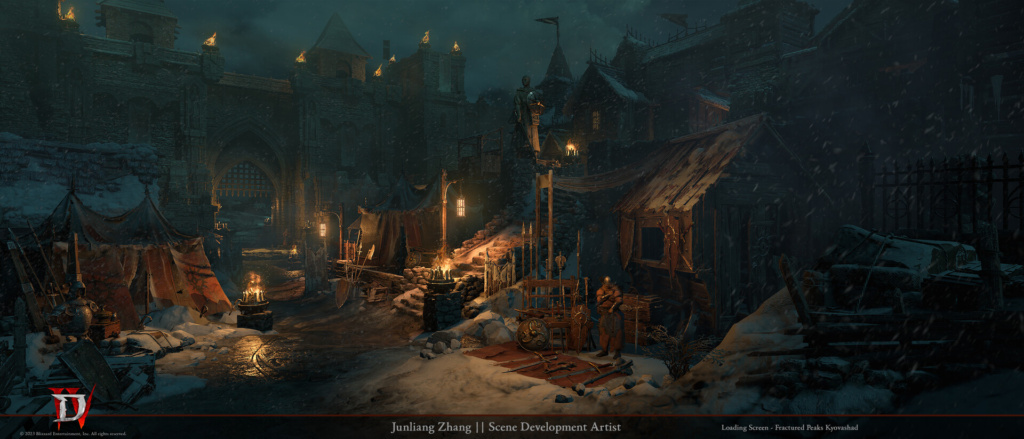
(Fractured Peaks Kyovashad)
At the beginning of the project, I usually create a series of scene sketches or silhouettes based on the game design document and creative direction requirements. These preliminary visual concept works are the cornerstone of the game’s visual style and atmosphere, providing direction and inspiration for subsequent environmental design. Once the preliminary concept art is determined, I transform these 2D scene concepts into 3D scenes. I am responsible for integrating these 3D models and other elements into the game environment, creating immersive and narrative game scenes. During the entire environmental design process, communication between team members is crucial. Regular meetings, work inspections, and feedback loops ensure that the project can progress smoothly and allow team members to iterate and optimize the design until everyone is satisfied.
2. How do you work with Narrative designers? Do you need to read the chapter/seasonal/version background story first to get ready for the design or you don’t need to care about Diablo lore at all?
Collaboration with narrative designers is a key aspect of the game environment design process, especially for games with deep storylines and complex worldviews, such as Diablo 4. To ensure that the environmental design not only visually appeals to players but also profoundly reflects and reinforces the game’s narrative content.
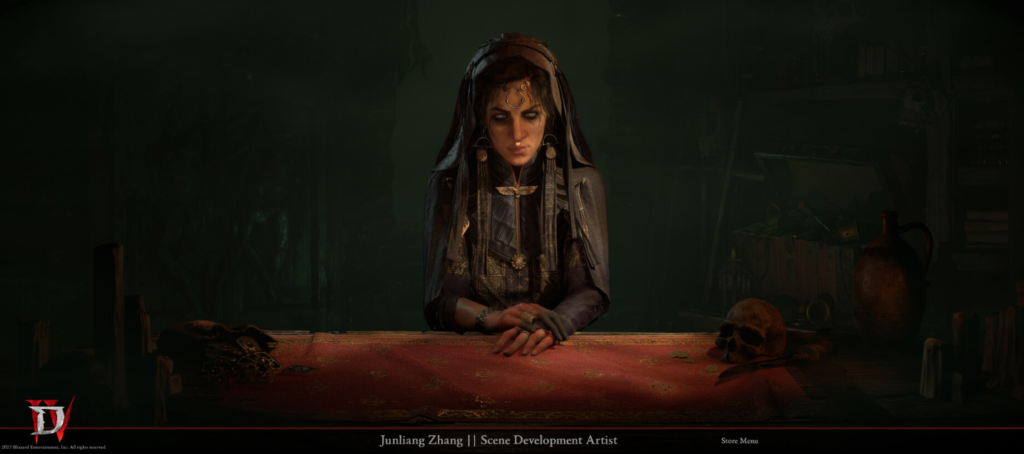
(Shop background)
Before starting the design work, it’s essential to have a deep understanding of the game’s chapters, seasons, or version background stories. This includes not only knowledge of the main storyline but also an in-depth study of the game world’s history, culture, geography, and key characters. By reading relevant documents, participating in creative discussions, or having one-on-one exchanges with narrative designers, I can ensure a comprehensive and profound understanding of the game’s narrative framework. Once I have a thorough understanding of the game’s narrative background, I can integrate narrative elements into the environmental design during the design process, such as reflecting specific themes or emotions of the game story through visual details like symbols in the scenes, architectural styles, and item placement. This integration of narrative and visual elements not only enhances the player’s immersion but also makes the game world richer and more authentic.
3. How long have you been working on the Diablo games, do you play the game? What attract you to join this team? What’s your favorite part about this game?
I have been working on the Diablo IV for around 3 years. I played Diablo series since 2000.
For the game itself, my favorite part might be its narrative depth and environmental design. An engaging story and a rich, multi-dimensional worldview can truly immerse players in the gaming experience. Moreover, carefully designed environments not only add to the game’s visual appeal but also enhance emotional engagement through visual storytelling. The aesthetic and emotional depth of this virtual world, created through art and technology, is very appealing to me.
(Stable)
4. What’s your favorite game, why do you like it? Did you get inspired by any scene designs from any other games?
I feel that each game is a unique piece of art, where the environment arts not only reflects the game’s theme and atmosphere but also showcases the designer’s creativity and technical prowess. By observing and analyzing the environmental design in different games, I can learn how to use elements such as light and shadow, color, composition, and texture to create a rich and diverse game world.
Hogwarts Legacy
This game has sold over 10 million PC copies so far, possibly one of the best Harry Porter games in its IP history. What part were you playing in the environment design of Hogwarts Legacy and what have you learned from this project?
Working on Hogwarts Legacy was not only to recreate the fantastical vision of a magic school but also to delve into the potential stories of each space, making them a bridge to connect with the player’s emotions. I meticulously examined every corner of the campus to ensure they not only presented the magical charm of the wizarding world but also integrated rich historical details and cultural elements. From the cracks in the fireplace that hint at historical vicissitudes to the secret passages in the library corners revealing ancient legends, every design detail aims to spark the player’s curiosity, guiding them to explore deeper and experience the depth and breadth of the game world.

General Questions
1. What would you prepare prior to participating in a new project?
Starting a visual project is a thrilling journey, beginning with the crucial step of gathering inspiring reference and concept art. This isn’t just about collecting images; it’s about finding that spark that ignites the creative process. Then, I dive deep into the story behind the scene, pondering over its nuances. This storytelling aspect is pivotal, guiding everything from the mood to the minute details of textures, transforming the project from a mere visual to a narrative that demands to be told.
The hunt for inspiration is extensive—I gather a vast array of references, curating mood boards that serve as a visual soundtrack for the project’s ambiance. This preparation is akin to laying the groundwork for what’s to come, setting the tone and direction with precision.
When it comes to sketching out the project, it’s about drafting the blueprint of the envisioned space, experimenting with layouts and styles to find the perfect fit. This phase is exploratory, allowing for the free flow of ideas and visualizing how elements interact within the space.
The construction of key structures employs modular modeling, a technique that offers unparalleled flexibility. Using Maya, I ensure that each component not only fits together flawlessly but can also be modified as needed, even after assembly. This adaptability is crucial, offering a blend of precision and creativity that allows for ongoing refinement without starting from scratch.
This methodical approach crystallizes my role within the project, laying down a robust foundation that is essential for its success. It’s about ensuring that every piece not only fits but also contributes to telling the story we set out to convey. By marrying methodical planning with creative freedom, the project not only comes to life but also connects with the audience on a deeper level, ensuring that the final piece is not just seen but felt.
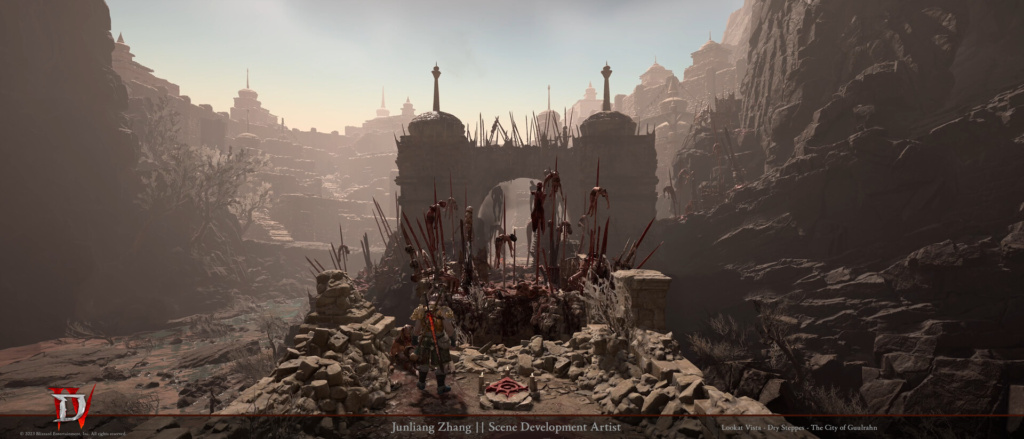
(Dry Stepps in Diablo 4)
2. What design style or theme are you fascinated with? Which artist has the most influence on you personally? What art form do you draw inspiration from?
I have a keen fascination with design styles that intertwine the grace of traditional art with the innovations of digital tools. This fusion not only highlights the synergy between art and technology but also births creations that embody timeless elegance alongside contemporary flair. A major source of my inspiration is Hayao Miyazaki from Studio Ghibli. His masterpieces, steeped in lush natural vistas and nuanced emotional portrayals, craft enchanting fantasy realms brimming with warmth and optimism through the medium of animation.
I’m equally captivated by art that weaves together diverse cultural threads, forging a distinct visual vernacular. Be it the fluidity of Eastern ink painting or the abstractness of Western surrealism, each offers fresh perspectives and sparks for my creativity. My interest extends to interactive art—installation art, VR, and AR projects stand out. These forms not only immerse but also push the boundaries of my creative thinking, driving me to explore new expressive avenues and inventive solutions at the crossroads of these dynamic fields.
3. What advice would you give to the early-career artists or newly-graduates with an art degree?
If you’re new to environmental art, keep diving into new software and sharpening your skills with regular practice. Understanding the basics like color theory, perspective, and how light works is key. But don’t forget to look around you; everyday life and both natural and urban landscapes are treasure troves of inspiration. Storytelling is crucial too—your designs should narrate something compelling. Building a diverse portfolio and getting involved in art communities can introduce you to the latest trends and valuable contacts. Embrace feedback, stay passionate, and keep an open mind. Success in environmental art doesn’t happen overnight; it takes patience and dedication. But stick with your unique passion and creativity, and you’ll carve out your own space in this ever-changing field. The journey is personal, so listen to and follow your own voice above all.
Junliang Zhang’s Portfolio:
https://www.artstation.com/scottjunliangzhang
https://www.linkedin.com/in/junliang-zhang
This is an original interview conducted by ArtiZen with the artist. If you are a media and interested in reposting this article, please get in touch with our editorial team for repost policy. [email protected]



